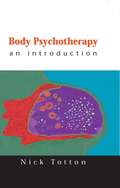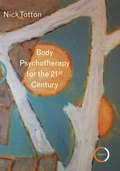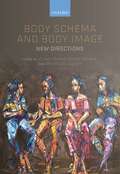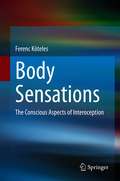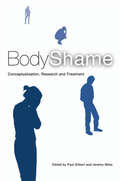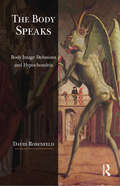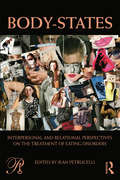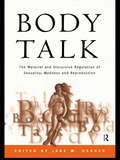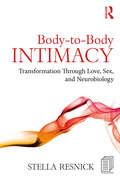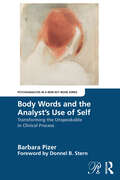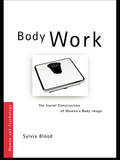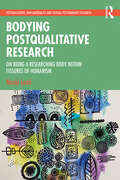- Table View
- List View
Body Psychotherapy (UK Higher Education OUP Humanities & Social Sciences Counselling and Psychotherapy)
by Nick Totton"...a well-rooted resource for bodywork courses and a useful introductory text for a broad audience." Caduceus"It's not a big book but it's got a vast amount of information and knowledge in it. ...if you are interested in getting a good overall picture of the subject you couldn't do better." The FulcrumBody psychotherapy is an holistic therapy which approaches human beings as united bodymind, and offers embodied relationship as its central therapeutic stance. Well-known forms include Reichian Therapy, Bioenergetics, Dance Movement Therapy, Primal Integration and Process Oriented Psychology.This new title examines the growing field of body psychotherapy: Surveys the many forms of body psychotherapy Describes what may happen in body psychotherapy and offers a theoretical account of how this is valuable drawing in current neuroscientific evidence Defines the central concepts of the field, and the unique skills needed by practitioners Accessible and practical, yet grounded throughout in current researchBody Psychotherapy: An Introduction is of interest to practitioners and students of all forms of psychotherapy and counselling, and anyone who wants to understand how mind and body together form a human being.
Body Psychotherapy for the 21st Century
by Nick TottonBody psychotherapy currently attracts more interest than ever before and is taking up an important role in the general psychotherapy field, bringing awareness of embodiment into what has been a verbally oriented profession. It is also developing a sophisticated approach which engages with recent advances in other fields including neuroscience, phenomenology, and cognitive studies, as well as the relational turn in psychotherapy. Body Psychotherapy for the 21st Century charts the history of this transformation and shows how four distinct versions of embodied practice have interacted to generate the current field. It makes the case for body psychotherapy not only within the therapeutic world, but in the social sphere, where bodily difference – of gender, ethnicity, age, sexuality – is one of the major markers of oppression.‘Nick Totton has been a pivotal figure in Body Psychotherapy, both as a historian and as a continual innovator and critic of BP and the whole psychotherapy field. This book has the vitality of genuine re-appraisal and both frankness and rigour in its argument and questions. Definitely a thought-provoking and up to date read.’ Roz Carroll, Relational body psychotherapist, trainer and author‘An exquisite introduction to Body Psychotherapy, describing the influences on its development and the models of working so that people new to this approach will be able to get an image of it. It also offers an excellent and clear overview that can be used by professionals in their further development of theory and methods.’ Lidy Evertsen, Chair, Think Tank of the European Association for Body Psychotherapy
Body Schema and Body Image: New Directions
by Yochai Ataria, Shogo Tanaka and Shaun GallagherBody schema is a system of sensory-motor capacities that function without awareness or the necessity of perceptual monitoring. Body image consists of a system of perceptions, attitudes, and beliefs pertaining to one's own body. In 2005 Shaun Gallagher published an influential book entitled How the Body Shapes the Mind (OUP). That book not only defined both body schema and body image, but explored the complicated relationship between the two. It also established the idea that there is a double dissociation, whereby body schema and body image refer to two different but closely related systems. Given that many kinds of pathological cases can be described in terms of body schema and body image (phantom limbs, asomatognosia, apraxia, schizophrenia, anorexia, depersonalization, and body dysmorphic disorder, among others), we might expect to find a growing consensus about these concepts and the relevant neural activities connected to these systems. Instead, an examination of the scientific literature reveals continued ambiguity and disagreement. This volume brings together leading experts from the fields of philosophy, neuroscience, psychology, and psychiatry in a lively and productive dialogue. It explores fundamental questions about the relationship between body schema and body image, and addresses ongoing debates about the role of the brain and the role of social and cultural factors in our understanding of embodiment.
Body Schema and Body Image: New Directions
Body schema is a system of sensory-motor capacities that function without awareness or the necessity of perceptual monitoring. Body image consists of a system of perceptions, attitudes, and beliefs pertaining to one's own body. In 2005 Shaun Gallagher published an influential book entitled How the Body Shapes the Mind (OUP). That book not only defined both body schema and body image, but explored the complicated relationship between the two. It also established the idea that there is a double dissociation, whereby body schema and body image refer to two different but closely related systems. Given that many kinds of pathological cases can be described in terms of body schema and body image (phantom limbs, asomatognosia, apraxia, schizophrenia, anorexia, depersonalization, and body dysmorphic disorder, among others), we might expect to find a growing consensus about these concepts and the relevant neural activities connected to these systems. Instead, an examination of the scientific literature reveals continued ambiguity and disagreement. This volume brings together leading experts from the fields of philosophy, neuroscience, psychology, and psychiatry in a lively and productive dialogue. It explores fundamental questions about the relationship between body schema and body image, and addresses ongoing debates about the role of the brain and the role of social and cultural factors in our understanding of embodiment.
Body Sensations: The Conscious Aspects of Interoception
by Ferenc KötelesThe monograph aims to present the recent scientific knowledge on body sensations, i.e., conscious experiences that are localized or felt in the body from an internal perspective, regardless of their sensory origin. It summarizes the basic philosophical, evolutionary, neuroanatomical, psychological, and pathological aspects of the topic. Moreover, related phenomena, such as emotions, the placebo and nocebo effect, complementary and alternative medicine, and mind-body practices are discussed from the perspective of body sensations.
Body Shame: Conceptualisation, Research and Treatment
by Paul Gilbert Jeremy MilesPhysical appearance plays a powerful role in social relationships. Those who feel shame regarding the way they look, and who think others view their appearance negatively, can therefore be vulnerable to impoverished social relationships and a range of psychological difficulties. However, there are a few books which look specifically at the many permutations of body shame and their differing treatments.In this book, researchers and therapists from a wide range of different disciplines and areas explore the role of shame in various physical and psychological disorders, and provide practical advice on management and treatment. Chapters are organised to address issues of conceptualisation, assessment and treatment, on topics such as:* definitional controversies* possible biopsychosocial and evolutionary origins of body shame* effects on adjustment to maturation and aging process* specific forms of disfigurement* the role of body shame in depression, eating disorders and body dysmorphic disorder.Body Shame gives the reader insight into the nature and mechanisms of shame, how it can focus on the body, how it can underlie a variety of psychological difficulties, and how to intervene to help resolve it. This book will be invaluable for practitioners from different disciplines working with people who have problems centred on their physical appearance and/or functions, and clinicians working with various mental health problems.
Body Shame: Conceptualisation, Research and Treatment
by Paul Gilbert Jeremy MilesPhysical appearance plays a powerful role in social relationships. Those who feel shame regarding the way they look, and who think others view their appearance negatively, can therefore be vulnerable to impoverished social relationships and a range of psychological difficulties. However, there are a few books which look specifically at the many permutations of body shame and their differing treatments.In this book, researchers and therapists from a wide range of different disciplines and areas explore the role of shame in various physical and psychological disorders, and provide practical advice on management and treatment. Chapters are organised to address issues of conceptualisation, assessment and treatment, on topics such as:* definitional controversies* possible biopsychosocial and evolutionary origins of body shame* effects on adjustment to maturation and aging process* specific forms of disfigurement* the role of body shame in depression, eating disorders and body dysmorphic disorder.Body Shame gives the reader insight into the nature and mechanisms of shame, how it can focus on the body, how it can underlie a variety of psychological difficulties, and how to intervene to help resolve it. This book will be invaluable for practitioners from different disciplines working with people who have problems centred on their physical appearance and/or functions, and clinicians working with various mental health problems.
The Body Speaks: Body Image Delusions and Hypochondria
by David RosenfeldThis book explores the author's pioneering work with severely disturbed patients, to show what it means to work and think as a psychoanalyst about transference and the internal world of a psychotic patient, with all the difficulties involved in continuing to treat and engage with even severely ill patients. As the author suggests, to be a psychoanalyst is to think about transference, the patient's internal world and projective identifications onto the therapist and onto persons in the external world. In particular, the author examines patients who express their mental state through fantasies about their body image. For example, the fantasy of an emptying of the self is discussed through the case of the patient Pierre, who asserts that he has no more blood or liquids in his body. Similarly, the fantasies of a young man who says that bats are flying out of his cheeks incarnate the anxiety of his first months of life expressed through his body. Indeed, the author's particular focus is on the importance of the first months and years in the life of these patients.
The Body Speaks: Body Image Delusions and Hypochondria
by David RosenfeldThis book explores the author's pioneering work with severely disturbed patients, to show what it means to work and think as a psychoanalyst about transference and the internal world of a psychotic patient, with all the difficulties involved in continuing to treat and engage with even severely ill patients. As the author suggests, to be a psychoanalyst is to think about transference, the patient's internal world and projective identifications onto the therapist and onto persons in the external world. In particular, the author examines patients who express their mental state through fantasies about their body image. For example, the fantasy of an emptying of the self is discussed through the case of the patient Pierre, who asserts that he has no more blood or liquids in his body. Similarly, the fantasies of a young man who says that bats are flying out of his cheeks incarnate the anxiety of his first months of life expressed through his body. Indeed, the author's particular focus is on the importance of the first months and years in the life of these patients.
Body-States: Interpersonal And Relational Perspectives On The Treatment Of Eating Disorders (Psychoanalysis in a New Key Book Series)
by Jean PetrucelliIn this edited volume, Jean Petrucelli brings together the work of talented clinicians and researchers steeped in working with eating disordered patients for the past 10 to 35 years. Eating disorders are about body-states and their relational meanings. The split of mindbody functioning is enacted in many arenas in the eating disordered patient’s life. Concretely, a patient believes that disciplining or controlling his or her body is a means to psychic equilibrium and interpersonal effectiveness. The collected papers in Body-States: Interpersonal and Relational Perspectives on the Treatment of Eating Disorders elaborates the essential role of linking symptoms with their emotional and interpersonal meanings in the context of the therapy relationship so that eating disordered patients can find their way out and survive the unbearable. The contributors bridge the gaps in varied protocols for recovery, illustrating that, at its core, trust in the reliability of the humanness of the other is necessary for patients to develop, regain, or have - for the first time - a stable body. They illustrate how embodied experience must be cultivated in the patient/therapist relationship as a felt experience so patients can experience their bodies as their own, to be lived in and enjoyed, rather than as an ‘other’ to be managed. In this collection Petrucelli convincingly demonstrates how interpersonal and relational treatments address eating problems, body image and "problems in living." Body States: Interpersonal and Relational Perspectives on the Treatment of Eating Disorders will be essential reading for psychoanalysts, psychotherapists, psychologists, psychiatrists, social workers, and a wide range of professionals and lay readers who are interested in the topic and treatment of eating disorders.
Body-States: Interpersonal And Relational Perspectives On The Treatment Of Eating Disorders (Psychoanalysis in a New Key Book Series)
by Jean PetrucelliIn this edited volume, Jean Petrucelli brings together the work of talented clinicians and researchers steeped in working with eating disordered patients for the past 10 to 35 years. Eating disorders are about body-states and their relational meanings. The split of mindbody functioning is enacted in many arenas in the eating disordered patient’s life. Concretely, a patient believes that disciplining or controlling his or her body is a means to psychic equilibrium and interpersonal effectiveness. The collected papers in Body-States: Interpersonal and Relational Perspectives on the Treatment of Eating Disorders elaborates the essential role of linking symptoms with their emotional and interpersonal meanings in the context of the therapy relationship so that eating disordered patients can find their way out and survive the unbearable. The contributors bridge the gaps in varied protocols for recovery, illustrating that, at its core, trust in the reliability of the humanness of the other is necessary for patients to develop, regain, or have - for the first time - a stable body. They illustrate how embodied experience must be cultivated in the patient/therapist relationship as a felt experience so patients can experience their bodies as their own, to be lived in and enjoyed, rather than as an ‘other’ to be managed. In this collection Petrucelli convincingly demonstrates how interpersonal and relational treatments address eating problems, body image and "problems in living." Body States: Interpersonal and Relational Perspectives on the Treatment of Eating Disorders will be essential reading for psychoanalysts, psychotherapists, psychologists, psychiatrists, social workers, and a wide range of professionals and lay readers who are interested in the topic and treatment of eating disorders.
Body Talk: The Material and Discursive Regulation of Sexuality, Madness and Reproduction
by Jane UssherPsychology has traditionally examined human experience from a realist perspective, focusing on observable 'facts'. This is especially so in areas of psychology which focus on the body, such as sexuality, madness or reproduction. In contrast, many sociologists, anthropologists and feminists have focused exclusively on the cultural and communicative aspects of 'the body' treating it purely as an object constructed within socio-cultural discourse.This new collection of sophisticated discursive analyses explores this divide from a variety of theoretical standpoints, including psychoanalysis, social representations theory, feminist theory, critical realism, post-structuralism and social constructionism.Body Talk reconciles the divide by putting forward a new 'materialist-discursive' approach. It also provides an introduction to social constructionist and discursive approaches which is accessible to those with limited previous knowledge of socio-linguistic theory, and showcases the distinctive contribution that psychologists can make to the field.
Body Talk: The Material and Discursive Regulation of Sexuality, Madness and Reproduction
by Jane UssherPsychology has traditionally examined human experience from a realist perspective, focusing on observable 'facts'. This is especially so in areas of psychology which focus on the body, such as sexuality, madness or reproduction. In contrast, many sociologists, anthropologists and feminists have focused exclusively on the cultural and communicative aspects of 'the body' treating it purely as an object constructed within socio-cultural discourse.This new collection of sophisticated discursive analyses explores this divide from a variety of theoretical standpoints, including psychoanalysis, social representations theory, feminist theory, critical realism, post-structuralism and social constructionism.Body Talk reconciles the divide by putting forward a new 'materialist-discursive' approach. It also provides an introduction to social constructionist and discursive approaches which is accessible to those with limited previous knowledge of socio-linguistic theory, and showcases the distinctive contribution that psychologists can make to the field.
Body Technologies in the Greco-Roman World: Technosôma, gender and sex
by Maria Gerolemou and Giulia Maria ChesiA collection of papers that introduces the notion of the technosoma (techno body) into discussions on the representations of the body in classical antiquity. By applying the category of the technosoma to the ‘natural’ body, this volume explicitly narrows down the discussion of the technical and the natural to the physiological body. In doing so, the present collection focuses on body technologies in the specific form of beautification and body enhancement techniques, as well as medical and surgical treatments. The volume elucidates two main points. Firstly, ancient techno bodies show that the categories of gender and sexuality are at the core of the intersection of the natural and the technical, and intersect with notions of race, age, speciesism, class and education, and dis/ability. Secondly, the collection argues that new body technologies have in fact a very ancient history that can help to address the challenges of contemporary technological innovation. To this end, the volume showcases the intersection of ‘natural’ bodies with technology, gender, sexuality and reproduction. On the one hand, techno bodies tend to align with normative ideas about gender, and sexuality. On the other hand, body modification and/or enhancement techniques work hand in hand with economic and political power and knowledge, thus they often produce techno bodies that are shaped according to individual needs, i.e. according to a certain lifestyle. Consequently, techno bodies threaten to alter traditional ideas of masculinity, femininity, male and female sexuality and beauty.
Body Technologies in the Greco-Roman World: Technosôma, gender and sex
A collection of papers that introduces the notion of the technosoma (techno body) into discussions on the representations of the body in classical antiquity. By applying the category of the technosoma to the ‘natural’ body, this volume explicitly narrows down the discussion of the technical and the natural to the physiological body. In doing so, the present collection focuses on body technologies in the specific form of beautification and body enhancement techniques, as well as medical and surgical treatments. The volume elucidates two main points. Firstly, ancient techno bodies show that the categories of gender and sexuality are at the core of the intersection of the natural and the technical, and intersect with notions of race, age, speciesism, class and education, and dis/ability. Secondly, the collection argues that new body technologies have in fact a very ancient history that can help to address the challenges of contemporary technological innovation. To this end, the volume showcases the intersection of ‘natural’ bodies with technology, gender, sexuality and reproduction. On the one hand, techno bodies tend to align with normative ideas about gender, and sexuality. On the other hand, body modification and/or enhancement techniques work hand in hand with economic and political power and knowledge, thus they often produce techno bodies that are shaped according to individual needs, i.e. according to a certain lifestyle. Consequently, techno bodies threaten to alter traditional ideas of masculinity, femininity, male and female sexuality and beauty.
Body-to-Body Intimacy: Transformation Through Love, Sex, and Neurobiology
by Stella ResnickThis book presents an integrative, growth-oriented approach to therapy with couples that demonstrates the dynamic interplay between partners’ emotional issues and their sexual difficulties. It offers a model for relational and sexual enhancement that focuses as much on partners’ present, nonverbal body-to-body communications as on their words. Dr. Stella Resnick draws on research from interpersonal neurobiology, sexology, positive psychology, and Gestalt therapy, and shares a rich assortment of therapy vignettes to demonstrate the transformative power of pleasure and how a focus on body-to-body intimacy can heal emotional wounds from the past and encourage greater presence, empathy, authenticity, playfulness, and sexual pleasure between intimate partners. The therapeutic process is explored in four related spectrums: the Problem-Transformation Spectrum, the Attachment-Sexuality Spectrum, the Pain-Pleasure Spectrum, and the Cognitive-Somatic-Experiential-Behavioral-Spectrum. Part I lays the theoretical foundation for the work. Part II examines the early attachment bond between parent and child and its effects on adult capacity for emotional closeness and sexual pleasure. Part III offers methods for resolving painful emotional issues underlying many sexual difficulties. Finally, Part IV describes the procedure for moving from a cognitive reframing of the problem to a somatic focus on the body and tracking present-moment emotional interactions to the repair of relational injuries that nurture transformational change. Also included is a series of process-oriented exercises and a handout that therapists can use in their own practice. Body-to-Body Intimacy will enable couples and sex therapists to expand their practices and enrich their clients’ sexual and relational dynamics. This book also contains valuable information that will be appreciated by anyone interested in a greater understanding of a growth-oriented therapeutic process for couples and what can be achieved together by gaining a deeply loving and sexually fulfilling intimate love relationship.
Body-to-Body Intimacy: Transformation Through Love, Sex, and Neurobiology
by Stella ResnickThis book presents an integrative, growth-oriented approach to therapy with couples that demonstrates the dynamic interplay between partners’ emotional issues and their sexual difficulties. It offers a model for relational and sexual enhancement that focuses as much on partners’ present, nonverbal body-to-body communications as on their words. Dr. Stella Resnick draws on research from interpersonal neurobiology, sexology, positive psychology, and Gestalt therapy, and shares a rich assortment of therapy vignettes to demonstrate the transformative power of pleasure and how a focus on body-to-body intimacy can heal emotional wounds from the past and encourage greater presence, empathy, authenticity, playfulness, and sexual pleasure between intimate partners. The therapeutic process is explored in four related spectrums: the Problem-Transformation Spectrum, the Attachment-Sexuality Spectrum, the Pain-Pleasure Spectrum, and the Cognitive-Somatic-Experiential-Behavioral-Spectrum. Part I lays the theoretical foundation for the work. Part II examines the early attachment bond between parent and child and its effects on adult capacity for emotional closeness and sexual pleasure. Part III offers methods for resolving painful emotional issues underlying many sexual difficulties. Finally, Part IV describes the procedure for moving from a cognitive reframing of the problem to a somatic focus on the body and tracking present-moment emotional interactions to the repair of relational injuries that nurture transformational change. Also included is a series of process-oriented exercises and a handout that therapists can use in their own practice. Body-to-Body Intimacy will enable couples and sex therapists to expand their practices and enrich their clients’ sexual and relational dynamics. This book also contains valuable information that will be appreciated by anyone interested in a greater understanding of a growth-oriented therapeutic process for couples and what can be achieved together by gaining a deeply loving and sexually fulfilling intimate love relationship.
Body Words and the Analyst’s Use of Self: Transforming the Unspeakable in Clinical Process (Psychoanalysis in a New Key Book Series)
by Barbara PizerIn this book, it becomes impossible to stand apart from the analytic field as abstract concepts, such as dissociation, intersubjectivity, and unconscious communication, as well as newly coined ones, like "Relational (K)not" and "Body Words," come alive through a vivid unfolding of analytic process.You are invited into the mind of the analyst as she draws from reverie, memory, and affect to inspire offerings that enliven the moment, moving the analytic pair forward in affective freedom and self-definition. Body Words identify the subjective linkages we make to describe experiencing within and between self and other that leads us to know whether we or our patient are delivering the message in a manner that feels real. Each chapter illustrates how Pizer arrived at this important concept and others in a way that is full of rich, experience-near clinical moments that posed significant challenges. Body Words and the Analyst's Use of Self is a rare window that allows readers—new and seasoned clinicians of various theoretical persuasions—to become intimate witnesses to the analyst's subjectivity and the creativity of the analytic partnership.
Body Words and the Analyst’s Use of Self: Transforming the Unspeakable in Clinical Process (Psychoanalysis in a New Key Book Series)
by Barbara PizerIn this book, it becomes impossible to stand apart from the analytic field as abstract concepts, such as dissociation, intersubjectivity, and unconscious communication, as well as newly coined ones, like "Relational (K)not" and "Body Words," come alive through a vivid unfolding of analytic process.You are invited into the mind of the analyst as she draws from reverie, memory, and affect to inspire offerings that enliven the moment, moving the analytic pair forward in affective freedom and self-definition. Body Words identify the subjective linkages we make to describe experiencing within and between self and other that leads us to know whether we or our patient are delivering the message in a manner that feels real. Each chapter illustrates how Pizer arrived at this important concept and others in a way that is full of rich, experience-near clinical moments that posed significant challenges. Body Words and the Analyst's Use of Self is a rare window that allows readers—new and seasoned clinicians of various theoretical persuasions—to become intimate witnesses to the analyst's subjectivity and the creativity of the analytic partnership.
Body Work: The Social Construction of Women's Body Image (Women and Psychology)
by Sylvia K. BloodAre scientific 'facts' about body image enough to define conceptions of normality? Reassessing Experimental Psychology from a critical perspective, Sylvia Blood demonstrates how its research into Body Image can be misused and prone to misuse. Classifying women who experience distress and anxiety with food, eating and body size as suffering 'body image disturbance' or 'body image dissatisfaction', it can reproduce dominant assumptions about language, meaning and subjectivity. Experimental psychology's discourse about body image has recently become more widely influential, becoming popularised through domains such as women’s magazines, in which psychological experts provide 'facts' about women's 'body image problems', and offer advice and psychological treatments. With acute cross-disciplinary awareness Body Work: The Social Construction of Women's Body Image exposes the assumptions at work in the methods and status of experimental approaches. Penetrating beyond the usual dichotomy between experimental and popular psychology, this book illuminates some of the ways in which women's magazines have embraced experimental psychology's treatment of the issue. Drawing on her experience in Clinical Psychology, Sylvia Blood highlights the damaging effects of uncritically experimental views of body image. She goes on to elaborate not only an alternative model of discursive construction but also the implications of such a theory for clinical practice. Merging theory and clinical experience, Sylvia Blood exposes the fallacies about women’s bodies that underpin experimental psychology's body image research. She demonstrates the dangerous consequences of these fallacies being accepted as truths in popular texts and in the talk of 'everyday' women.
Body Work: The Social Construction of Women's Body Image (Women and Psychology)
by Sylvia K. BloodAre scientific 'facts' about body image enough to define conceptions of normality? Reassessing Experimental Psychology from a critical perspective, Sylvia Blood demonstrates how its research into Body Image can be misused and prone to misuse. Classifying women who experience distress and anxiety with food, eating and body size as suffering 'body image disturbance' or 'body image dissatisfaction', it can reproduce dominant assumptions about language, meaning and subjectivity. Experimental psychology's discourse about body image has recently become more widely influential, becoming popularised through domains such as women’s magazines, in which psychological experts provide 'facts' about women's 'body image problems', and offer advice and psychological treatments. With acute cross-disciplinary awareness Body Work: The Social Construction of Women's Body Image exposes the assumptions at work in the methods and status of experimental approaches. Penetrating beyond the usual dichotomy between experimental and popular psychology, this book illuminates some of the ways in which women's magazines have embraced experimental psychology's treatment of the issue. Drawing on her experience in Clinical Psychology, Sylvia Blood highlights the damaging effects of uncritically experimental views of body image. She goes on to elaborate not only an alternative model of discursive construction but also the implications of such a theory for clinical practice. Merging theory and clinical experience, Sylvia Blood exposes the fallacies about women’s bodies that underpin experimental psychology's body image research. She demonstrates the dangerous consequences of these fallacies being accepted as truths in popular texts and in the talk of 'everyday' women.
BodyDreaming in the Treatment of Developmental Trauma: An Embodied Therapeutic Approach
by Marian DunleaMarian Dunlea’s BodyDreaming in the Treatment of Developmental Trauma: An Embodied Therapeutic Approach provides a theoretical and practical guide for working with early developmental trauma. This interdisciplinary approach explores the interconnection of body, mind and psyche, offering a masterful tool for restoring balance and healing developmental trauma. BodyDreaming is a somatically focused therapeutic method, drawing on the findings of neuroscience, analytical psychology, attachment theory and trauma therapy. In Part I, Dunlea defines BodyDreaming and its origins, placing it in the context of a dysregulated contemporary world. Part II explains how the brain works in relation to the BodyDreaming approach: providing an accessible outline of neuroscientific theory, structures and neuroanatomy in attunement, affect regulation, attachment patterns, transference and countertransference, and the resolution of trauma throughout the body. In Part III, through detailed transcripts from sessions with clients, Dunlea demonstrates the positive impact of BodyDreaming on attachment patterns and developmental trauma. This somatic approach complements and enhances psychobiological, developmental and psychoanalytic interventions. BodyDreaming restores balance to a dysregulated psyche and nervous system that activates our innate capacity for healing, changing our default response of "fight, flight or freeze" and creating new neural pathways. Dunlea’s emphasis on attunement to build a restorative relationship with the sensing body creates a core sense of self, providing a secure base for healing developmental trauma. Innovative and practical, and with a foreword by Donald E. Kalsched, BodyDreaming in the Treatment of Developmental Trauma: An Embodied Therapeutic Approach will be essential reading for psychotherapists, analytical psychologists and therapists with a Jungian background, arts therapists, dance and movement therapists, and body workers interested in learning how to work with both body and psyche in their practices.
BodyDreaming in the Treatment of Developmental Trauma: An Embodied Therapeutic Approach
by Marian DunleaMarian Dunlea’s BodyDreaming in the Treatment of Developmental Trauma: An Embodied Therapeutic Approach provides a theoretical and practical guide for working with early developmental trauma. This interdisciplinary approach explores the interconnection of body, mind and psyche, offering a masterful tool for restoring balance and healing developmental trauma. BodyDreaming is a somatically focused therapeutic method, drawing on the findings of neuroscience, analytical psychology, attachment theory and trauma therapy. In Part I, Dunlea defines BodyDreaming and its origins, placing it in the context of a dysregulated contemporary world. Part II explains how the brain works in relation to the BodyDreaming approach: providing an accessible outline of neuroscientific theory, structures and neuroanatomy in attunement, affect regulation, attachment patterns, transference and countertransference, and the resolution of trauma throughout the body. In Part III, through detailed transcripts from sessions with clients, Dunlea demonstrates the positive impact of BodyDreaming on attachment patterns and developmental trauma. This somatic approach complements and enhances psychobiological, developmental and psychoanalytic interventions. BodyDreaming restores balance to a dysregulated psyche and nervous system that activates our innate capacity for healing, changing our default response of "fight, flight or freeze" and creating new neural pathways. Dunlea’s emphasis on attunement to build a restorative relationship with the sensing body creates a core sense of self, providing a secure base for healing developmental trauma. Innovative and practical, and with a foreword by Donald E. Kalsched, BodyDreaming in the Treatment of Developmental Trauma: An Embodied Therapeutic Approach will be essential reading for psychotherapists, analytical psychologists and therapists with a Jungian background, arts therapists, dance and movement therapists, and body workers interested in learning how to work with both body and psyche in their practices.
Bodying Postqualitative Research: On Being a Researching Body within Fissures of Humanism (Postqualitative, New Materialist and Critical Posthumanist Research)
by Nicole LandBodying Postqualitative Research posits the question of what happens when lived, fleshy human bodies engage in postqualitative research in education. It takes as its central concern research propositions aimed at dismantling the structures of humanism that typically govern research in education and uses postqualitative conceptions of data, methodology, and clarity in conjunction with insights from feminist science studies scholars to imagine how we might ‘body’ postqualitative work. This book uses the provocations offered by postqualitative research and takes these touchpoints to dismantle dominant logics of research, born of neoliberalism and ongoing settler colonialism to offer alternative perspectives. Importantly, this book stays near to the body by proposing caffeine shakes, antipsychotic medications, and scars as moments to take seriously how bodies do researching practices. After each chapter, the book turns to poetry as a "fracture" or a moment of disruption to the rhythm of the text that incites readers to reconsider the previous chapter otherwise. It concludes by asking what bodying postqualitative research might mean for pedagogy and for propositions toward future inquiry. Drawing together the work of feminist science and education scholars oriented toward the biosciences and whose work has not yet been immersed into postqualitative scholarship in a sustained way, this book brings together a vein of feminist science studies theorizing that both deepens and troubles postqualitative scholarship through its focus on the politics of science and the possibilities of doing bodies with biology, culture, and life. The volume is suitable for students and scholars interested in postqualitative and embodied research methods in education, and feminist and gender studies.
Bodying Postqualitative Research: On Being a Researching Body within Fissures of Humanism (Postqualitative, New Materialist and Critical Posthumanist Research)
by Nicole LandBodying Postqualitative Research posits the question of what happens when lived, fleshy human bodies engage in postqualitative research in education. It takes as its central concern research propositions aimed at dismantling the structures of humanism that typically govern research in education and uses postqualitative conceptions of data, methodology, and clarity in conjunction with insights from feminist science studies scholars to imagine how we might ‘body’ postqualitative work. This book uses the provocations offered by postqualitative research and takes these touchpoints to dismantle dominant logics of research, born of neoliberalism and ongoing settler colonialism to offer alternative perspectives. Importantly, this book stays near to the body by proposing caffeine shakes, antipsychotic medications, and scars as moments to take seriously how bodies do researching practices. After each chapter, the book turns to poetry as a "fracture" or a moment of disruption to the rhythm of the text that incites readers to reconsider the previous chapter otherwise. It concludes by asking what bodying postqualitative research might mean for pedagogy and for propositions toward future inquiry. Drawing together the work of feminist science and education scholars oriented toward the biosciences and whose work has not yet been immersed into postqualitative scholarship in a sustained way, this book brings together a vein of feminist science studies theorizing that both deepens and troubles postqualitative scholarship through its focus on the politics of science and the possibilities of doing bodies with biology, culture, and life. The volume is suitable for students and scholars interested in postqualitative and embodied research methods in education, and feminist and gender studies.
